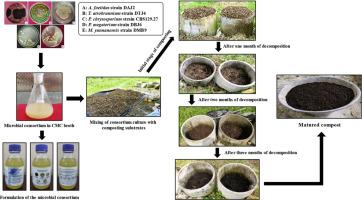Rapid composting of groundnut residues through novel microbial consortium: Evaluating maturity, stability, and microbial activity
IF 4.8
Q1 MICROBIOLOGY
引用次数: 0
Abstract
A laboratory pot experiment (Experiment 1) was conducted to determine the optimal ratio of groundnut haulm and shell as composting substrates. The aim was to identify the most effective combination for rapid decomposition under in vivo conditions. The experiment was carried out in 2022, from May to July, using a completely randomized design (CRD) with 6 treatments that were replicated 4 times. The treatment combinations in the pot experiment were as follows: T1: haulm + shell (1:1), T2: haulm + shell (2:1), T3: haulm + shell (3:1), T4: T1 + Cn, T5: T2 + Cn, and T6: T3 + Cn. Here, Cn refers to the cellulose-degrading efficient microbial consortium containing bacterial strains Priestia megaterium DBJ6, Micrococcus yunnanensis DMB9, and fungal strains Aspergillus foetidus DAJ2, Trichoderma atrobrunnium DTJ4, and Phanerochaete chrysosporium CBS129.27. Based on the results (results of chemical and biological properties) of the pot experiment, treatment T6 was considered the best treatment (the C/N ratio was 14.36 ± 0.444 after three months of decomposition) for further study under in vivo conditions. The in vivo experiment (Experiment 2) was conducted at the Jaguli Instructional Farm of Bidhan Chandra Krishi Viswavidyalaya, West Bengal, India, during the months of August to October in both 2022 and 2023 with two treatments: the normal composting treatment (NC) and the rapid composting treatment (RC). The findings of Experiment 2 showed that organic substrates degraded more quickly (within 90 days) during rapid composting, as evidenced by a decrease in the C/N ratio to below 15 (14.32 and 13.97 on day 90 in 2022 and 2023, respectively). Whereas, normal composting required more than 90 days to achieve a C/N ratio below 20 (23.80 and 23.15 on day 90 in 2022 and 2023, respectively). The RC treatment also showed a higher microbial population and enzyme activity compared to the NC treatment. Therefore, according to the results of this experiment, it can be concluded that the inoculation of the microbial consortium was more beneficial for accelerating the composting process under the same composting circumstances and substrate ratio.

通过新型微生物群快速堆肥花生残渣:评估成熟度、稳定性和微生物活性
为了确定花生秆和壳作为堆肥基质的最佳比例,我们进行了一次实验室盆栽实验(实验 1)。目的是确定在活体条件下快速分解的最有效组合。实验于 2022 年 5 月至 7 月进行,采用完全随机设计(CRD),6 个处理重复 4 次。盆栽实验中的处理组合如下:T1:秆+壳(1:1);T2:秆+壳(2:1);T3:秆+壳(3:1);T4:T1:T1 + Cn;T5:T2 + Cn;T6:T3 + Cn。这里的 Cn 指的是纤维素降解高效微生物联合体,包括细菌菌株 Priestia megaterium DBJ6、Micrococcus yunnanensis DMB9 和真菌菌株 Aspergillus foetidus DAJ2、Trichoderma atrobrunnium DTJ4 和 Phanerochaete chrysosporium CBS129.27。根据盆栽实验的结果(化学和生物特性结果),处理 T6 被认为是最佳处理(三个月分解后的 C/N 比为 14.36 ± 0.444),可在体内条件下进一步研究。活体实验(实验 2)于 2022 年和 2023 年的 8 月至 10 月在印度西孟加拉邦 Bidhan Chandra Krishi Viswavidyalaya 的 Jaguli 教学农场进行,分为两种处理:普通堆肥处理(NC)和快速堆肥处理(RC)。实验 2 的结果表明,在快速堆肥过程中,有机基质的降解速度更快(90 天内),具体表现为 C/N 比值降至 15 以下(2022 年和 2023 年第 90 天分别为 14.32 和 13.97)。而正常堆肥需要 90 多天才能使 C/N 比值低于 20(2022 年和 2023 年第 90 天分别为 23.80 和 23.15)。与 NC 处理相比,RC 处理的微生物数量和酶活性也更高。因此,根据本实验的结果,可以得出结论:在相同的堆肥环境和基质比例下,接种微生物菌群更有利于加速堆肥过程。
本文章由计算机程序翻译,如有差异,请以英文原文为准。
求助全文
约1分钟内获得全文
求助全文
来源期刊

Current Research in Microbial Sciences
Immunology and Microbiology-Immunology and Microbiology (miscellaneous)
CiteScore
7.90
自引率
0.00%
发文量
81
审稿时长
66 days
 求助内容:
求助内容: 应助结果提醒方式:
应助结果提醒方式:


